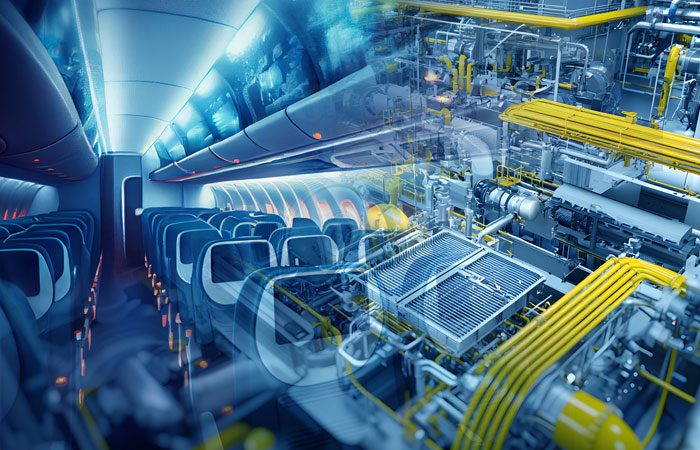
IIoT in Oil and Gas: Improving Safety and Productivity
The oil and gas industry is one of the most complex and hazardous sectors, characterized by massive infrastructure, intricate processes, and high-risk operations. The emergence of the Industrial Internet of Things (IIoT) is transforming this industry, offering innovative solutions that enhance safety and productivity.
IIoT enables real-time data collection and analysis, remote monitoring, predictive maintenance, and automation, addressing key challenges in the oil and gas sector.
This article explores how IIoT is revolutionizing safety and productivity in oil and gas operations and the impact it can have on industry sustainability and profitability.
Addressing the Need for IIoT in Oil and Gas
The oil and gas industry faces several operational challenges, including harsh working environments, aging infrastructure, equipment breakdowns, and fluctuating oil prices. These factors contribute to a high-risk environment where even small inefficiencies can result in significant losses. The integration of IIoT technology offers an intelligent, data-driven approach to these challenges, providing the industry with real-time insights, enhanced safety protocols, and optimized processes.
IIoT encompasses various connected devices and sensors that collect data from the physical world and communicate it over the internet. This real-time data flow allows for the automation of critical functions, predictive analytics for maintenance, and the creation of safer operational environments.
Improving Safety in Oil and Gas with IIoT
Safety is a top priority in the oil and gas industry due to the inherent risks involved in exploration, drilling, extraction, and transportation. From hazardous working conditions to the potential for accidents or environmental disasters, ensuring worker safety and environmental protection is essential.
IIoT plays a crucial role in improving safety through enhanced monitoring and data-driven safety protocols.
- Real-Time Asset Monitoring
IIoT allows for the continuous monitoring of assets such as pipelines, drilling equipment, and machinery. Sensors are deployed to track critical parameters like temperature, pressure, and flow rates, providing real-time data to operators. Any anomalies or potential failures can be identified early, allowing for prompt intervention. For example, sensors can detect a pressure build-up in a pipeline, helping prevent dangerous blowouts or leaks that could result in fires or environmental damage.
- Predictive Maintenance
IIoT technology enables predictive maintenance by analyzing data from equipment and machinery. In the oil and gas industry, unplanned equipment failure can result in costly downtime and even hazardous situations. IIoT sensors track machinery performance, alerting operators when equipment needs maintenance before it fails.
This predictive maintenance approach reduces the risk of accidents caused by malfunctioning equipment, minimizes downtime, and cuts maintenance costs.
- Worker Safety and Monitoring
IIoT can enhance worker safety by monitoring the working conditions in hazardous environments. Wearable sensors, such as smart helmets or vests, can track the health and well-being of workers in real-time, detecting heat stress, exposure to toxic gases, or abnormal physiological conditions. These sensors can trigger alerts to supervisors, enabling rapid response to potential dangers.
Additionally, IIoT allows for geo-fencing and remote monitoring of high-risk zones. By defining virtual perimeters around hazardous areas, alerts can be generated if workers inadvertently enter unsafe zones, reducing the chances of accidents.
- Environmental Safety and Compliance
The oil and gas industry is subject to strict environmental regulations, and IIoT can help companies meet compliance standards by monitoring environmental parameters. Sensors can track emissions, water quality, and soil conditions around drilling sites and pipelines. If a breach or leakage is detected, the system can automatically shut down operations or activate containment measures. This not only reduces the environmental impact but also helps avoid costly regulatory fines.
Enhancing Productivity in Oil and Gas with IIoT
In addition to improving safety, IIoT is a powerful tool for boosting productivity in oil and gas operations. The ability to collect and analyze vast amounts of data in real-time enables better decision-making, optimized resource utilization, and more efficient processes. Here’s how IIoT drives productivity in the industry:
- Enhanced Operational Efficiency
The real-time data provided by IIoT sensors allows operators to make informed decisions quickly. IIoT systems can continuously monitor production processes and identify areas of inefficiency, such as energy waste or equipment underperformance. By addressing these issues in real-time, operators can optimize production output and reduce operational costs.
For example, an IIoT-enabled oil well can automatically adjust its pumping speed based on real-time data, maximizing the flow rate without overworking the equipment. This level of automation and optimization improves operational efficiency and boosts overall production.
- Automated Drilling and Extraction
IIoT-powered automation is transforming the drilling and extraction process in the oil and gas sector. By deploying smart sensors and AI-driven analytics, companies can automate various stages of the drilling process, reducing the need for manual intervention and the potential for human error.
Autonomous drilling rigs equipped with IIoT devices can make precise adjustments in real-time to optimize drilling depth, pressure, and speed. Automated extraction processes can also be fine-tuned to minimize energy consumption and maximize resource recovery. As a result, companies can extract oil and gas more efficiently, leading to higher productivity and profitability.
- Supply Chain Optimization
The oil and gas supply chain is complex, involving multiple stages from exploration to refining and distribution. IIoT provides end-to-end visibility of the supply chain by tracking assets, inventory, and logistics in real-time. Companies can monitor the movement of oil and gas products through pipelines, storage facilities, and transportation networks, ensuring timely deliveries and reducing the risk of bottlenecks.
Furthermore, IIoT can help optimize inventory management by forecasting demand based on historical data and current market trends. This helps avoid overproduction, minimize storage costs, and ensure that resources are efficiently allocated.
- Remote Monitoring and Control
One of the significant advantages of IIoT is its ability to enable remote monitoring and control of oil and gas operations. Operators can monitor equipment performance and environmental conditions from central control rooms or even mobile devices. This is particularly valuable in offshore rigs or remote locations, where direct human intervention is limited.
IIoT allows operators to remotely control pumps, valves, and other critical equipment, making real-time adjustments without requiring onsite personnel. This reduces the need for onsite visits and decreases the risk of human error, leading to increased productivity and cost savings.
- Data-Driven Decision Making
IIoT generates a wealth of data that can be analyzed to identify trends, optimize processes, and predict future performance. By using advanced analytics, oil and gas companies can make data-driven decisions that improve productivity. For instance, historical data from sensors can be used to optimize drilling schedules, improve extraction rates, or forecast equipment maintenance needs.
The ability to make informed decisions based on real-time and historical data allows oil and gas companies to operate more efficiently, reduce downtime, and increase overall productivity.
How Engineering Specialists Can Help Implement IIoT?
While the benefits of IIoT in the oil and gas industry are evident, implementing IIoT solutions requires expertise in both industrial processes and cutting-edge technology. Engineering specialist firms like TAAL Tech play a crucial role in helping oil and gas companies integrate IIoT into their operations. These firms bring deep domain knowledge, technical expertise, and experience in deploying IIoT solutions that are tailored to the unique needs of the oil and gas sector.
- Tailored IIoT Solutions
Engineering firms work closely with oil and gas companies to develop customized IIoT solutions that address specific operational challenges. This includes selecting the right sensors, designing data communication networks, and integrating IIoT platforms with existing systems. Tailored solutions ensure that IIoT technologies align with the company’s production goals and safety requirements.
- Seamless Integration
Engineering specialists handle the seamless integration of IIoT solutions into complex oil and gas infrastructures. Whether it’s retrofitting IIoT devices into existing machinery or developing new automation processes, these firms ensure that the transition to IIoT is smooth and cost-effective, minimizing disruption to ongoing operations.
- Continuous Support and Maintenance
IIoT systems require ongoing monitoring and maintenance to ensure they operate at peak efficiency. Engineering firms offer continuous support services, providing real-time monitoring, troubleshooting, and software updates. This ensures that the IIoT infrastructure remains up-to-date and continues to deliver safety and productivity benefits over the long term.
IIoT is transforming the oil and gas industry by improving safety, enhancing productivity, and driving operational efficiency. From predictive maintenance to real-time monitoring and automation, IIoT technologies offer unprecedented opportunities to streamline processes, reduce risks, and increase profitability. With the support of engineering specialists, oil and gas companies can successfully implement IIoT solutions, unlocking the full potential of smart operations in this dynamic industry.
The Industrial Internet of Things (IIoT) is transforming the industrial landscape by connecting machines, sensors, and devices, enabling real-time data collection and analysis. This connectivity brings unprecedented efficiency, productivity, and innovation opportunities. However, it also introduces significant cybersecurity risks. As industrial systems become increasingly interconnected, they become more vulnerable to cyber threats, making the security of IIoT systems paramount.
In this blog, we will explore the importance of securing IIoT systems and provide strategies to mitigate cyber threats, addressing the concerns of clients worried about data breaches and security risks.
The Importance of Securing IIoT Systems
- Protecting Critical Infrastructure
IIoT systems are often integrated into critical infrastructure, such as power grids, water treatment facilities, and transportation systems. A cyber attack on these systems can have catastrophic consequences, leading to service disruptions, safety hazards, and economic losses. Ensuring the security of IIoT systems is essential to protect public safety and maintain the continuity of essential services.
- Safeguarding Sensitive Data
IIoT systems collect vast amounts of data, including operational information, production metrics, and even employee and customer data. This data is valuable to cybercriminals who can exploit it for financial gain or industrial espionage. Securing IIoT systems helps protect sensitive data from unauthorized access and theft.
- Maintaining Operational Continuity
Cyber attacks can disrupt industrial operations, leading to downtime and productivity losses. For instance, a ransomware attack can lock down critical systems, forcing companies to halt production until the issue is resolved. By securing IIoT systems, companies can minimize the risk of operational disruptions and ensure business continuity.
- Compliance with Regulations
Many industries are subject to strict regulations regarding data protection and cybersecurity. Non-compliance can result in hefty fines, legal penalties, and reputational damage. Implementing robust IIoT security measures helps companies comply with regulatory requirements and avoid potential legal and financial repercussions.
Strategies to Mitigate Cyber Threats in IIoT Systems
- Implementing Strong Authentication and Access Controls
One of the most effective ways to secure IIoT systems is by implementing strong authentication and access controls. This includes using multi-factor authentication (MFA) to verify user identities and restricting access to sensitive systems and data based on the principle of least privilege. Role-based access control (RBAC) can help ensure that users only have access to the resources they need for their specific roles.
- Encrypting Data at Rest and in Transit
Data encryption is crucial for protecting sensitive information from unauthorized access and tampering. Encrypting data at rest ensures that even if an attacker gains physical access to storage devices, they cannot read the data without the encryption key. Encrypting data in transit protects it from interception and eavesdropping as it moves between devices and systems. Implementing end-to-end encryption ensures that data remains secure throughout its lifecycle.
- Regularly Updating and Patching Systems
Keeping IIoT devices and systems up to date with the latest software patches and security updates is essential for protecting against known vulnerabilities. Cybercriminals often exploit unpatched vulnerabilities to gain access to systems and networks. Regularly updating and patching systems helps close these security gaps and reduces the risk of exploitation.
- Segmenting Networks
Network segmentation involves dividing a network into smaller, isolated segments to limit the spread of cyber threats. By segmenting IIoT networks, companies can contain the impact of a potential breach and prevent attackers from moving laterally across the network. Implementing firewalls, virtual local area networks (VLANs), and intrusion detection systems (IDS) can help enforce network segmentation and enhance security.
- Monitoring and Analyzing Network Traffic
Continuous monitoring and analysis of network traffic can help detect and respond to cyber threats in real time. Implementing intrusion detection and prevention systems (IDPS) can alert security teams to suspicious activity and block malicious traffic.
Advanced threat detection tools, such as Security Information and Event Management (SIEM) systems, can provide comprehensive visibility into network activity and facilitate rapid incident response.
- Implementing Robust Endpoint Security
IIoT devices often have limited security features, making them attractive targets for cybercriminals. Implementing robust endpoint security measures, such as anti-malware software, intrusion prevention systems, and device management solutions, can help protect IIoT devices from cyber threats. Regularly updating firmware and applying security patches is also essential for maintaining the security of IIoT endpoints.
- Conducting Regular Security Assessments and Penetration Testing
Regular security assessments and penetration testing can help identify vulnerabilities in IIoT systems before cybercriminals can exploit them. Conducting these assessments allows companies to proactively address security weaknesses and strengthen their defenses. Engaging third-party security experts to perform penetration testing can provide an unbiased evaluation of the security posture and identify potential areas for improvement.
- Implementing Security Policies and Employee Training
Establishing comprehensive security policies and procedures is essential for guiding the organization’s approach to IIoT security. These policies should cover aspects such as access control, data protection, incident response, and employee responsibilities. Additionally, providing regular cybersecurity training to employees helps raise awareness about cyber threats and promotes best practices for maintaining security. Employees should be educated on how to recognize phishing attempts, secure their devices, and report suspicious activities.
As IIoT systems continue to revolutionize industrial operations, securing these systems against cyber threats becomes increasingly critical. The potential consequences of a cyber attack on IIoT systems, including service disruptions, data breaches, and operational downtime, underscore the importance of robust cybersecurity measures.
By implementing strong authentication and access controls, encrypting data, regularly updating systems, segmenting networks, monitoring network traffic, securing endpoints, conducting security assessments, and fostering a security-aware culture, companies can effectively mitigate cyber threats and protect their industrial assets in a connected world.
Securing IIoT systems is not just a technical challenge; it is a strategic imperative that requires ongoing vigilance and commitment. By prioritizing cybersecurity and adopting a proactive approach, companies can harness the full potential of IIoT while safeguarding their critical infrastructure, sensitive data, and operational continuity. In an era where cyber threats are constantly evolving, a comprehensive and adaptive IIoT security strategy is essential for ensuring a resilient and secure industrial environment.


